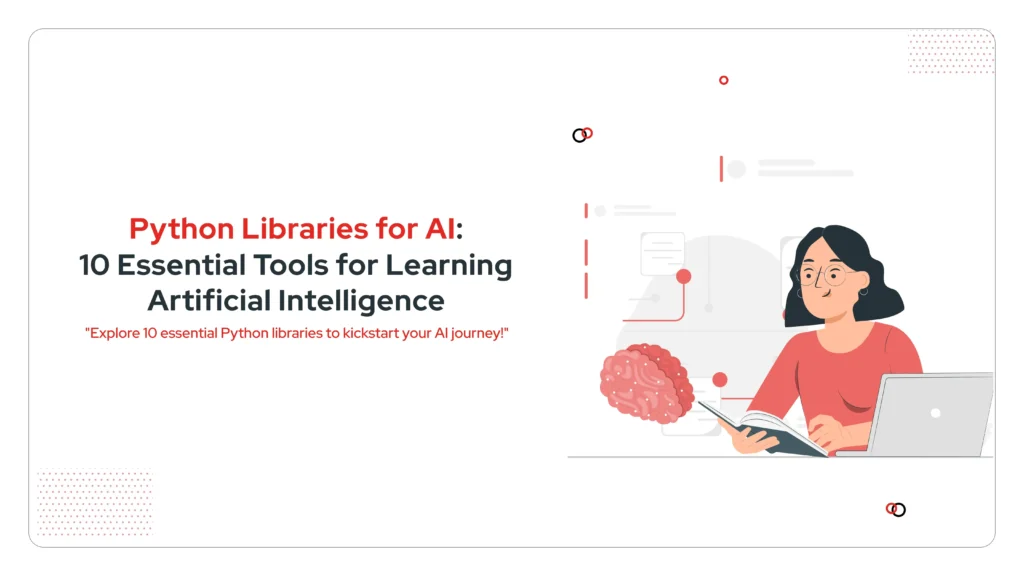
Artificial Intelligence (AI) has revolutionized the way we interact with technology. From self-driving cars to medical diagnostics, AI is reshaping industries across the globe. Python, a versatile and beginner-friendly programming language, has emerged as the go-to language for AI development. Its rich ecosystem of libraries empowers developers to build sophisticated AI applications, from simple machine learning models to complex deep learning architectures.
The Importance of Embracing AI Skills in Today’s Evolving World
In today’s world, learning AI is essential due to its vast impact across industries. AI enhances efficiency, automates repetitive tasks, and enables data-driven decisions, which boosts productivity in fields like healthcare, finance, and education. As more companies adopt AI for innovation, understanding its basics can open career opportunities and ensure individuals stay relevant in a tech-driven job market.
Moreover, AI literacy empowers people to use these tools responsibly, addressing ethical considerations and potential biases. In an era where digital transformation is accelerating, learning AI equips individuals with the skills needed to navigate and thrive in a connected, AI-integrated world.
Top 10 Essential Tools for Learning Artificial Intelligence
NumPy – Core for Numerical Computing
NumPy, the cornerstone of scientific computing in Python, provides powerful tools for working with arrays and matrices. It’s the foundation for many other AI libraries, enabling efficient numerical operations, linear algebra, and random number generation.
- Pandas – Data Analysis and Manipulation
Pandas is a high-performance library for data analysis and manipulation. It offers data structures like DataFrames and Series, which are ideal for handling and cleaning real-world datasets. Pandas simplifies data cleaning, exploration, and preparation for machine learning tasks.
Matplotlib and Seaborn – Data Visualization
Matplotlib and Seaborn are powerful libraries for creating informative and visually appealing data visualizations. Matplotlib provides a flexible framework for customizing plots, while Seaborn offers a higher-level interface for creating statistical graphics.
Scikit-learn – Machine Learning Algorithms
Scikit-learn is a comprehensive library for machine learning tasks, including classification, regression, clustering, and model selection. It provides a user-friendly interface and a wide range of algorithms, making it a great starting point for beginners.
TensorFlow and Keras – Deep Learning
TensorFlow and Keras are powerful libraries for building and training deep learning models. TensorFlow, developed by Google, offers a flexible framework for defining and optimizing neural networks. Keras, a high-level API built on top of TensorFlow, simplifies the process of building deep learning models.
PyTorch – Dynamic Computation Graphs
PyTorch is a popular deep learning framework known for its dynamic computation graphs. It allows for more flexibility in model definition and training, making it suitable for research and prototyping. PyTorch’s intuitive API and strong community support have contributed to its growing popularity.
OpenCV – Computer Vision
OpenCV is a powerful library for computer vision tasks, such as image processing, object detection, and facial recognition. It provides a wide range of functions for manipulating images and videos, making it essential for AI applications in fields like robotics and autonomous vehicles.
NLTK – Natural Language Processing
NLTK, the Natural Language Toolkit, is a comprehensive library for natural language processing tasks, including text classification, sentiment analysis, and machine translation. It offers many tools for tokenization, stemming, lemmatization, and part-of-speech tagging.
XGBoost – Gradient Boosting
XGBoost is a high-performance library for gradient boosting algorithms, which are powerful techniques for classification and regression tasks. It offers efficient implementation and optimization techniques, making it popular for machine learning competitions and real-world applications.
Hugging Face Transformers – State-of-the-Art NLP
Hugging Face Transformers provide access to state-of-the-art pre-trained models for natural language processing tasks, such as text generation, translation, and question answering. It simplifies building powerful language models, even for those without extensive NLP expertise.
Additional Tips for Learning AI with Python
To effectively learn AI with Python, start by building a solid foundation in Python programming. Begin with core concepts like data structures, control flow, and functions, as a strong grasp of these basics will ease your journey into AI. Practice is key; regularly working on small projects allows you to apply what you’ve learned and gain hands-on experience, deepening your understanding of both Python and AI techniques.
Additionally, joining online communities and forums can be invaluable. Connecting with other learners and professionals provides a support network where you can ask questions, share insights, and stay motivated throughout your learning process.
Final Thoughts!
Python’s extensive ecosystem of libraries has solidified its status as the leading language for AI development. Gaining proficiency in these ten essential tools will empower you to address diverse AI challenges effectively. However, true success in AI extends beyond familiarity with libraries; it lies in grasping the foundational concepts and algorithms that drive these technologies.
By understanding both the tools and the theory behind AI, you’ll be better prepared to create innovative, efficient solutions. As AI continues to evolve, building this comprehensive knowledge base will be invaluable for staying adaptable and advancing within the field.